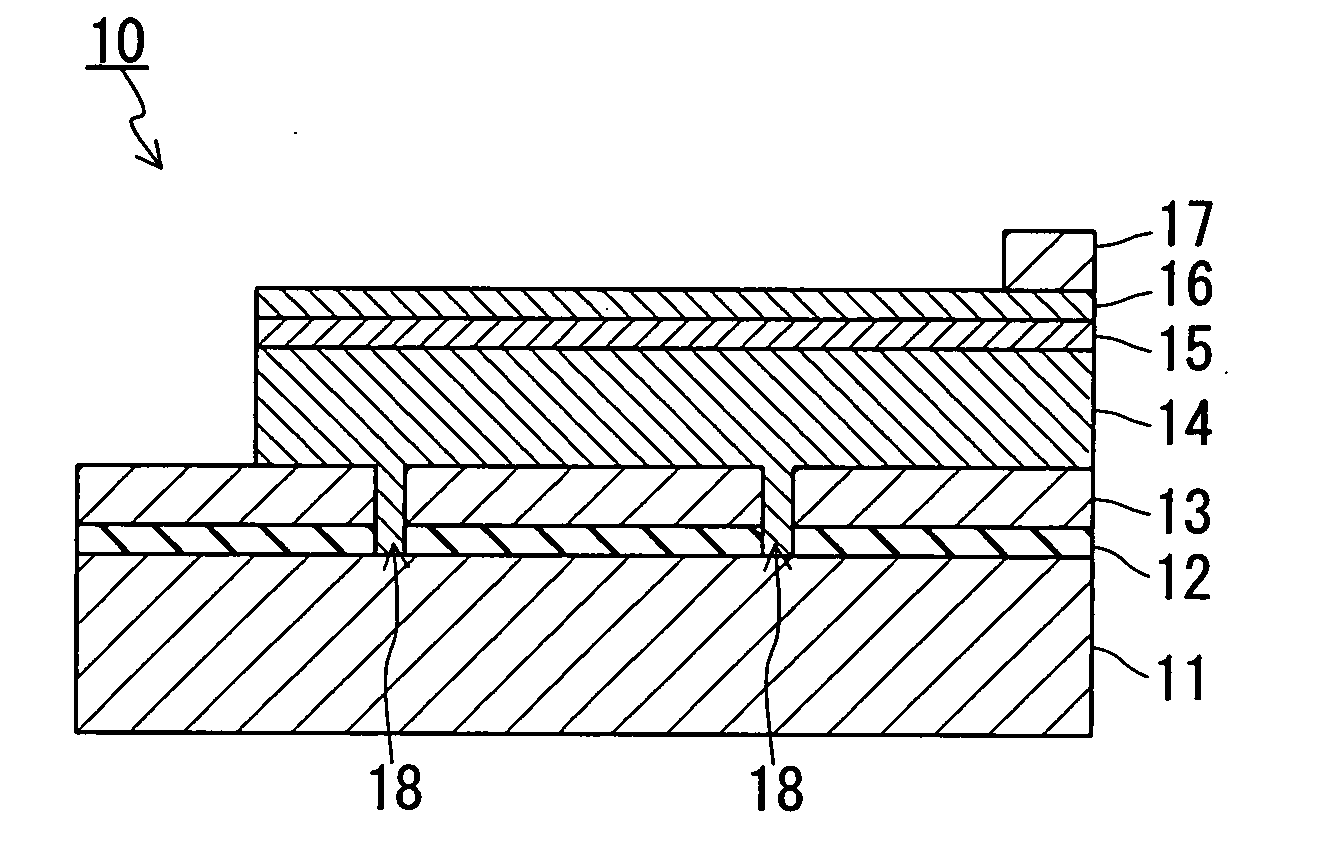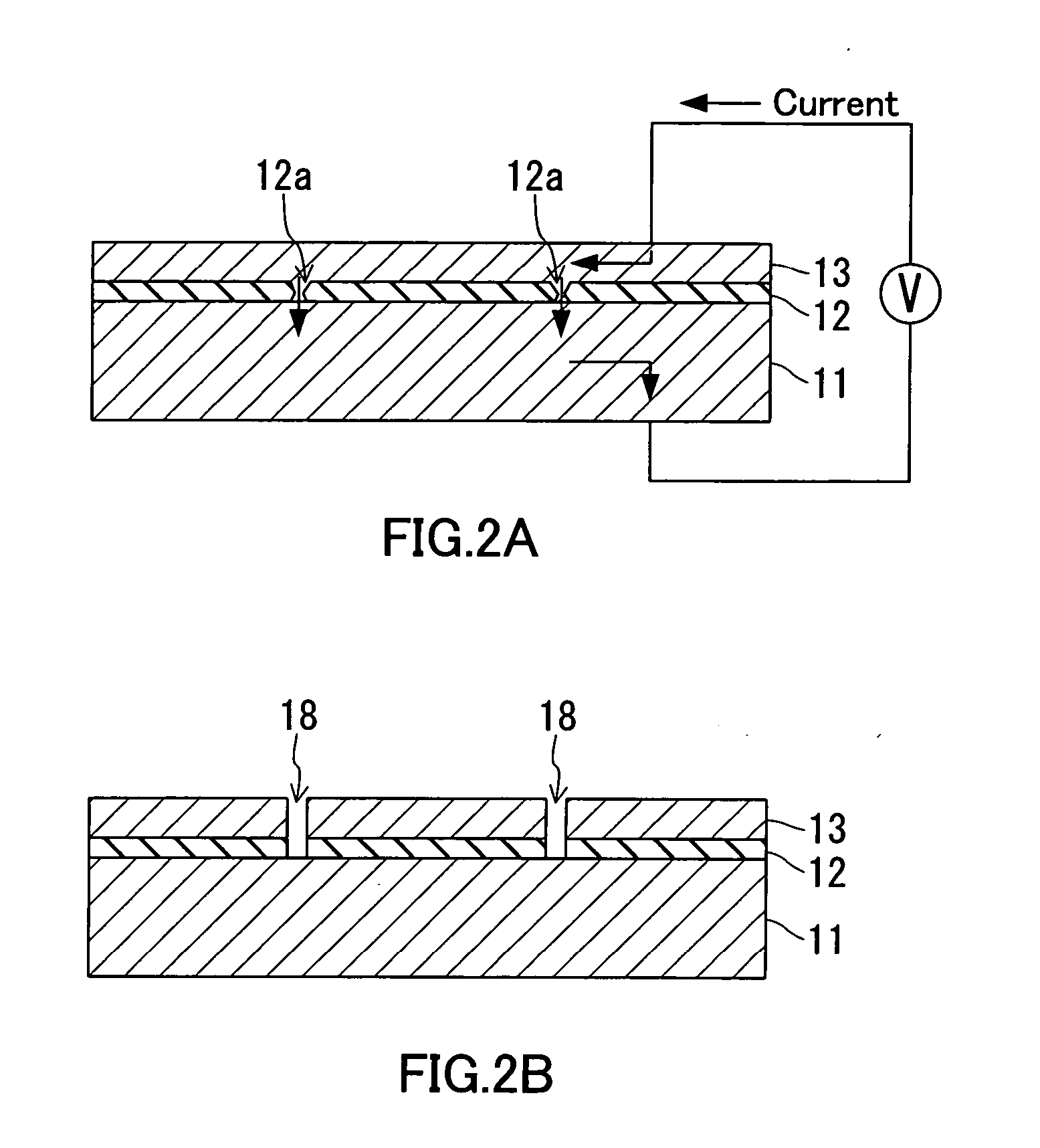Solar cell and its manufacturing method
a manufacturing method and solar cell technology, applied in the field of solar cells, can solve the problems of degrading the efficiency of solar cell modules, low conversion efficiency, and inability to manufacture integrated solar cells, and achieve excellent properties and reliability
- Summary
- Abstract
- Description
- Claims
- Application Information
AI Technical Summary
Benefits of technology
Problems solved by technology
Method used
Image
Examples
embodiment 1
[0036] In Embodiment 1, an example of a configuration of a thin-film solar cell of the present invention will be described.
[0037] The cross-sectional view of a solar cell of Embodiment 1 is shown in FIG. 1. As shown in FIG. 1, a solar cell 10 of Embodiment 1 includes a conductive substrate 11, an insulating layer 12 formed on the conductive substrate 11, a conducting layer 13 formed on the insulating layer 12, a semiconductor layer 14 formed on the conducting layer 13, a window layer 15 formed on the semiconductor layer 14, a transparent conductive film 16 formed on the window layer 15, and an extraction electrode 17 formed on the transparent conductive film 16. Moreover, a second window layer made of a semiconductor or an insulator may be further provided between the window layer 15 and the transparent conductive film 16.
[0038] In the insulating layer 12 and the conducting layer 13, a through hole 18 is formed so as to penetrate them. The through hole 18 is filled with a semicond...
embodiment 2
[0054] In Embodiment 2, an example of a thin-film solar cell of the present invention will be described. More specifically, one example of an integrated solar cell module, in which plural solar cells (unit cells) are serially connected on a substrate, will be described.
[0055] The cross-sectional view of a solar cell module of Embodiment 2 is shown in FIG. 4. As illustrated in FIG. 4, a solar cell module 20 of Embodiment 2 includes a conductive substrate 21, an insulating layer 22 formed on the conductive substrate 21, a conducting layer 23 that functions as a backside electrode and is formed on the insulating layer 22, a semiconductor layer 24 that functions an optical absorption layer and is formed on the conducting layer 23, a window layer 25 made of a semiconductor or an insulator formed on the semiconductor layer 24, and a transparent conductive film 26 formed on the window layer 25. Moreover, a second window layer made of a semiconductor or an insulator further can be provided...
example 1
[0071] Example 1 is directed to a solar cell of Embodiment 1 and an example of a method for manufacturing the same.
[0072] A configuration of a solar cell 30 will be described, with reference to FIG. 6. In Example 1, a stainless substrate 31 (thickness: 50 μm) for the conductive substrate 11, a SiO2 layer 32 (thickness: 0.5 μm) for the insulating layer 12, a Mo layer 33 (thickness: 0.8 μm) for the conducting layer 13, a CIGS layer 34 (thickness: 2 μm) for the semiconductor layer 14 that functions as an optical absorption layer, a CdS layer 35a (thickness: 0.1 μm) for the first window layer of the window layer 15, a ZnO layer 35b (thickness: 0.1 μm) for the second window layer of the window layer 15, an ITO film 36 (thickness: 0.1 μm) for the transparent conductive film 16, and a laminating film 37 of NiCr / Al (overall thickness: 1.5 μm) for the extraction electrode 17 were used.
[0073] Next, a method for manufacturing a solar cell is described as follows. Firstly, a SiO2 layer 32 was...
PUM
 Login to View More
Login to View More Abstract
Description
Claims
Application Information
 Login to View More
Login to View More - R&D
- Intellectual Property
- Life Sciences
- Materials
- Tech Scout
- Unparalleled Data Quality
- Higher Quality Content
- 60% Fewer Hallucinations
Browse by: Latest US Patents, China's latest patents, Technical Efficacy Thesaurus, Application Domain, Technology Topic, Popular Technical Reports.
© 2025 PatSnap. All rights reserved.Legal|Privacy policy|Modern Slavery Act Transparency Statement|Sitemap|About US| Contact US: help@patsnap.com



